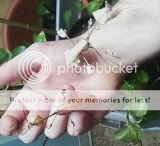I decided TODAY to re-group and rid the morph idea. Mantis aren't like this, are they?
I have been told that some species such as B. Mendica show different characteristics by location. Some B. Mendica are smaller and some show much more vivid greens, if this is a fact, which hasn't been proven yet? Locales are real. So, is it possible with Violins? I'm assuming it is possible, however, these were produced by the same clutch, so this isn't something that literally can be split up. I made the mistake, and I apologize for that. If each different looking female came from different wild caught females/ooths than I would consider doing this, but in this situation, this is not the case.
I am still going to mix the lighter colored females with the lighter males, and the females with the odd smokey tints with tiny forest green markings with the darker colored males.
I am hoping this lineage will be producing even more unusual looking specimens, once I mix some of my females with unrelated Violins. I am bringing a couple different lines, (as I was told by both parties, they were produced from wild caught ooths that were in fact brought in at different times).
Unfortunately most of these Violins don't share the super white "head cap thingy" lol Phil!

However, I was told they aren't super dark and not all of them look a like which is my ideal goal. To mix, match, and produce "different" looking Violins. Let's face it, Violins have been brought down tremendously these past several months. I aim to bring these back to the status that they belong to, these are really cool! lol












